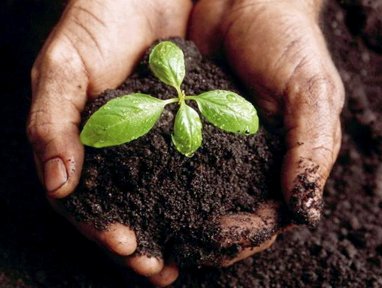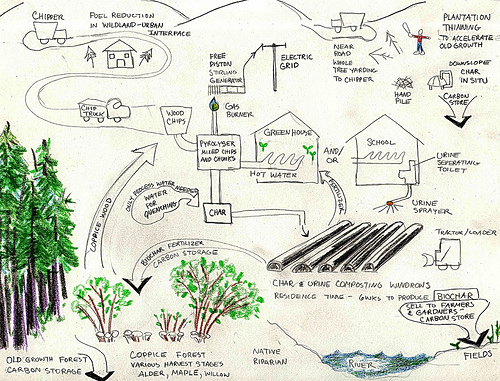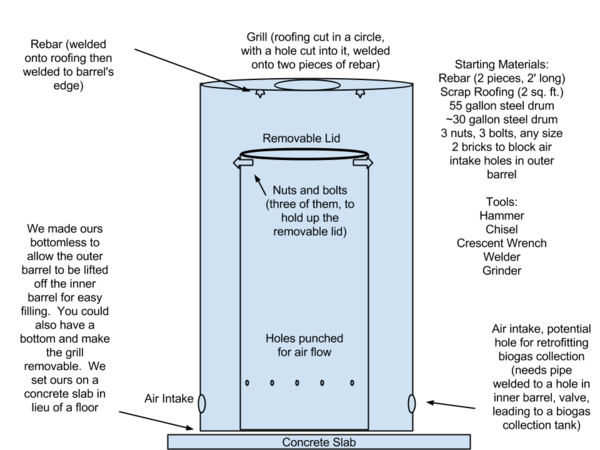Biochar: Difference between revisions
(→Links: +link) |
(section: videos) |
||
| Line 84: | Line 84: | ||
The bottom line is that the biochar will initially take nitrogen out of the soil, potentially reducing yields until it is saturated. This can be avoided by adding nitrogen to the biochar before or during incorporation into the soil. | The bottom line is that the biochar will initially take nitrogen out of the soil, potentially reducing yields until it is saturated. This can be avoided by adding nitrogen to the biochar before or during incorporation into the soil. | ||
==Videos== | |||
* BadgerChar batch farm scale char maker - [https://www.youtube.com/watch?v=fFtM3M7kIDE] | |||
<html> | |||
<iframe width="560" height="315" src="https://www.youtube.com/embed/fFtM3M7kIDE" frameborder="0" allowfullscreen></iframe> | |||
<iframe width="560" height="315" src="https://www.youtube.com/embed/svNg5w7WY0k" frameborder="0" allowfullscreen></iframe> | |||
</html> | |||
==Links== | ==Links== | ||
* Wikipedia entry on Biochar [http://en.wikipedia.org/wiki/Biochar] | * Wikipedia entry on Biochar [http://en.wikipedia.org/wiki/Biochar] | ||
* How to make it: [http://www.instructables.com/id/How-to-Make-some-Charcoal/ Instructable on the retort kiln] | * How to make it: [http://www.instructables.com/id/How-to-Make-some-Charcoal/ Instructable on the retort kiln] | ||
* "Gardening with Biochar FAQ" [http://biochar.pbwiki.com/], about small-scale gardening with biochar, an excellent resource. | * "Gardening with Biochar FAQ" [http://biochar.pbwiki.com/], about small-scale gardening with biochar, an excellent resource. | ||
* BioEnergy Lists: Terra Preta (Biochar) [http://terrapreta.bioenergylists.org/] | * BioEnergy Lists: Terra Preta (Biochar) [http://terrapreta.bioenergylists.org/] | ||
Revision as of 01:32, 13 March 2016
Main > Food and Agriculture > Soil and compost
According to the International Biochar Initiative: "Biochar is a fine-grained charcoal high in organic carbon and largely resistant to decomposition. It is produced from pyrolysis of plant and waste feedstocks. As a soil amendment, biochar creates a recalcitrant soil carbon pool that is carbon-negative, serving as a net withdrawal of atmospheric carbon dioxide stored in highly recalcitrant soil carbon stocks. The enhanced nutrient retention capacity of biochar-amended soil not only reduces the total fertilizer requirements but also the climate and environmental impact of croplands.
Char-amended soils have shown 50 - 80 percent reductions in nitrous oxide emissions and reduced runoff of phosphorus into surface waters and leaching of nitrogen into groundwater. As a soil amendment, biochar significantly increases the efficiency of and reduces the need for traditional chemical fertilizers, while greatly enhancing crop yields. Renewable oils and gases co-produced in the pyrolysis process can be used as fuel or fuel feedstocks. Biochar thus offers promise for its soil productivity and climate benefits."''
Some of the world's most productive soils (e.g. Canadian prairies, Russian Chernozem / or "black earth") are very rich in organic carbon, probably pyrogenic in origin and originating from prairie or forest fires. The black carbon is often thousands of years old, demonstrating its stability in soil. For more extensive background on Biochar, please look up the Wikipedia entry, read File:SCM-30.pdf or consult the website of the International Biochar Initiative.
There is some evidence that high-quality biochar requires low operating pressures, to allow volatiles to escape during the reaction. Therefore, the attempt to use pyrolysis gases and even just a retort may lead to inferior char. The Earth Pit Kiln and the Kon-Tiki Kiln operate at low (i.e. atmospheric) pressure.
Product ecology and The Biochar Economy
- Inexpensive soil amelioration for degraded land
- Increased biomass productivity
- Reduced need for fertilizer input (e.g. manure).
- biochar added to biogas fermenter may improve methane production (see reference)
- Composting: combine biochar with Vermiculture for superb fertilizer, or add to compost heap to speed up composting (works via enhanced microbial activity);
- biochar to neutralize smell in composting, e.g. with composting toilet
- biochar-producing tractor: the Charvester
- Bio-oil and tars are also by-products of pyrolysis, can be turned into biodiesel
- Use Lifetrac (and soil pulverizer) to mix char into soil, till
- Biochar for sale as a source of income, especially when "aged" (i.e. composted, vermicomposted)
- biomass waste for energy generation
- Pyrolysis gas can be used for energy (i.e. compressed fuel gas) and as a heat source (e.g. for heating greenhouses). As a source of hydrogen, CO and small amounts of methane, pyrolysis gas may be useful for various processes
- Charcoal is already needed for other purposes, e.g. metal smelting
- Charcoal as filter: can be used for water purification and filtration, later become biochar; can be used to filter pyrolysis gas itself (also see: biofilter)
- See Also: Kiln
Potential Co-Products

- The standard co-product with biochar is heat. Use for space heating (greenhouses, hot water, steam for cleaning or steam engine)
- heat for: fired ceramics, tiles, terracotta, glassmaking, ...
- The CO2-rich off-gas may also potentially be used as a plant stimulant, if the combustion is very clean (e.g. with Kon-Tiki Kiln). Some plants are more sensitive to combustion-derived impurities than others. The exhaust gas can be purified with a soil biofilter.
- Biochar-Lime Co-production System
- Biochar/Brick Co-production System
- Pyrolysis Oil
- Bone Char can be made in the same process as biochar
- internal combustion engine (requires very clean wood gas, with filters and ad-hoc fractional distillation system) - see video by MrTeslonian
Discussion
Could someone suggest a design for a simple flexi-pyrolysis unit that makes both charcoal and syngas ?
- Yes, the Biochar Experimenter's Kit -- it's open source.
Some discussion of Biochar manufacture and use (including reference to mobile pyrolyser developed at VA Tech) on this blog posting: Turning Points - Biochar: Make It or Buy It?. Two earlier posts on biochar from Turning Points blog.
Dan Schellenberg's Biocharred Soil Sample
- When large chunks of wood are used as feedstock, they may need to be crushed before use (beware: coal dust explosion !). See Biochar Crusher for more about this.
Field Trial Results by BlueLeaf / Dynamotive (March 2011)
"Biochar Commercial Agriculture Field Trial in Québec, Canada – Year Three: Effects of Biochar on Forage Plant Biomass Quantity, Quality and Milk Production" (Full details of the report available here, internal copy)
These are the first biochar field trials undertaken in northerly latitudes (45° north).
Key results include:
- Continued greater biomass growth for the third consecutive year in biochar-amended soils
- Nutritional quality of plants grown in biochar-amended soil is verified by near infrared spectroscopy for first time
- Plant nutrient uptake efficiency and plant nutritional quality is greater in plants grown in biochar-amended soil
- This greater plant nutritional value leads to greater milk production from these forage plants
- In addition to the greater nutritional value of plants grown in biochar-amended soil as well as greater milk production, environmental advantages are anticipated through reduced leaching and reduced greenhouse gas emissions
- These results were achieved with a relatively low biochar application rate (3.9 t/ha), in a northerly climate (N45˚), on normal agricultural soils.
The results of these trials reinforce other research pointing to potentially important advantages for the use of biochar as an agricultural soil amendment, both for economic and environmental reasons.
Data of effect of biochar on yield
- The trial cited above by BlueLeaf found modest increases in yield. Dry matter yields were increased by only 2.7% after three years applying biochar. However, the plants grown (forage for ruminants) were more nutritious on the biochar-treated fields, so researchers project a 19.7% increase in the yield of milk from animals grazing there.
- This trial found that biochar alone had no effect on yields, but when applied along with N fertilizer, there was a synergistic effect. Biochar alone gave 0% increase, N fertilizer alone gave 95% increase, while biochar and N fertilizer increased yield 266%
- This trial on maize yields in Ghana found a 91% increase in yield.
- This study found a 42% increase in yield when 10 tonnes/hectare were applied and a 96% increase at 50t/ha (that's 5kg/m2 for those of us with less land)
- This study found no increase the first year, 28% the next year, 30% the following year, and 140% the year after that. Application was 20t/ha, or 2kg/m2
- This found a decrease in yield, even though the soil was poor in carbon to begin with.
The bottom line is that the biochar will initially take nitrogen out of the soil, potentially reducing yields until it is saturated. This can be avoided by adding nitrogen to the biochar before or during incorporation into the soil.
Videos
- BadgerChar batch farm scale char maker - [1]
Links
- Wikipedia entry on Biochar [2]
- How to make it: Instructable on the retort kiln
- "Gardening with Biochar FAQ" [3], about small-scale gardening with biochar, an excellent resource.
- BioEnergy Lists: Terra Preta (Biochar) [4]
- International Biochar Initiative (IBI) [5]
- Folke Günther's "the simplest of the simple" retort two-barrel charcoal retort
- Poster: OpenChar Initiative [6] (internal copy on this wiki)
- Review article on Biochar [7] (internal copy on this wiki)
- Ithaka Journal: "Treating liquid manure with biochar"
- Ithaka Journal: "Biochar in poultry farming"



